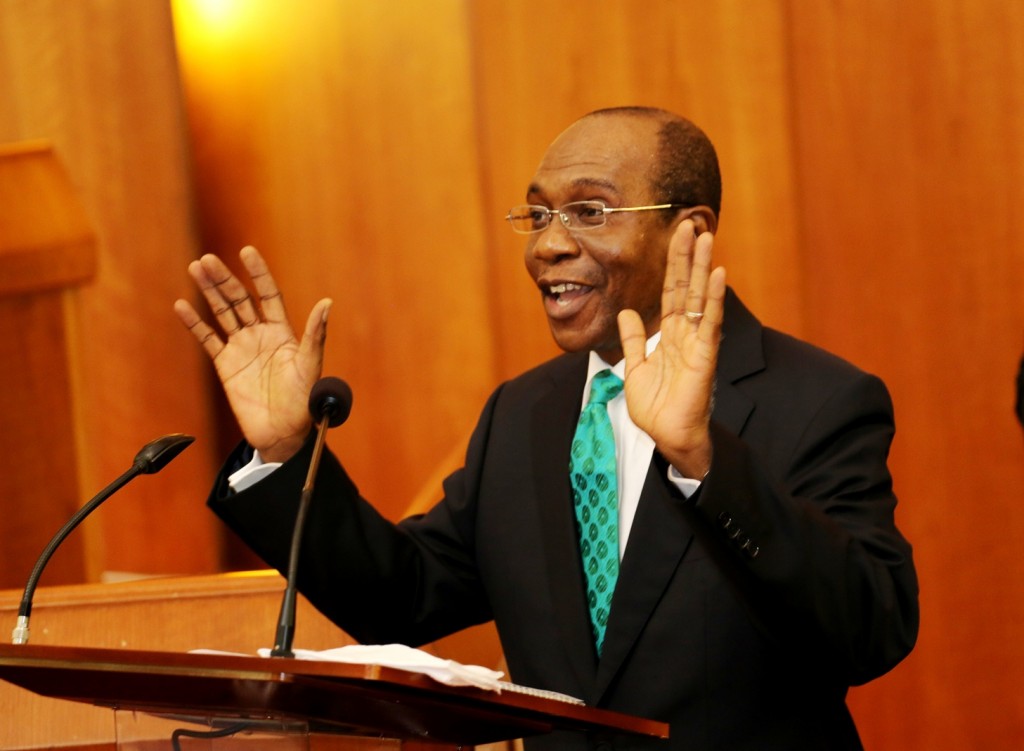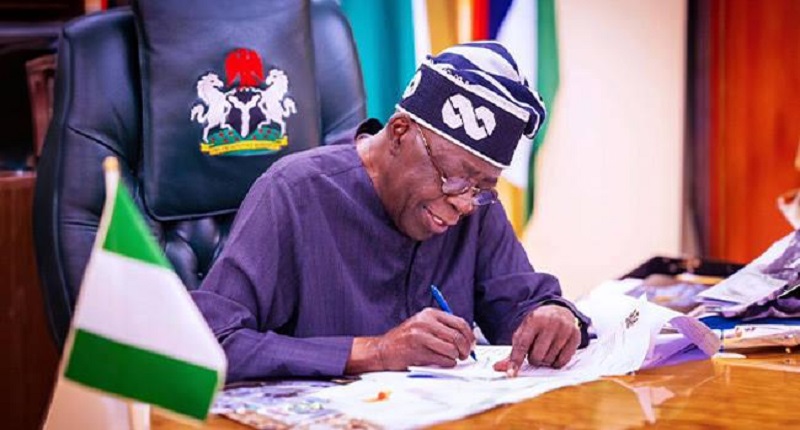Economy
Emefiele Kept £543.4m in Fixed Deposit, Operated 593 Bank Accounts, Manipulated Exchange Rate—Investigator

By Adedapo Adesanya
Nigeria’s embattled former central bank governor, Mr Godwin Emefiele, has been accused of operating 593 bank accounts located in the United States, United Kingdom and China in which the Central Bank of Nigeria (CBN), under his supervision, kept Nigerian funds without authorisation by the Board and Investment Committee of the bank.
The findings were made by the Special Investigator probing the CBN, Mr Jim Obazee, who was appointed by President Bola Tinubu to look into the books.
The investigator also discovered how billions of Naira were allegedly stolen by Mr Emefiele and other officials from the CBN’s accounts, including a “fraudulent cash withdrawal of $6.23 million” – about N2.9 billion at the then official exchange rate of N461 to a dollar.
Mr Obazee disclosed these in his report in which he recommended the prosecution of Mr Emefiele and at least 13 other individuals, including his deputy governors, for alleged gross financial offences.
The Special Investigator also identified other offences, including fraudulent use of Ways and Means to the tune of N26.627 trillion; fraudulent intervention programmes, fraudulent expenditures on COVID-19, and misrepresentation of presidential approval on the NESI Stabilisation Strategy Limited.
In the UK alone, the Special Investigator said his probe led him to £543.4 million kept by Mr Emefiele in fixed deposit accounts. He also said Mr Emefiele manipulated the Naira exchange rate and perpetrated fraud in the e-Naira project of the CBN.
In his report, which was submitted to President Tinubu on December 9, the Special Investigator said the Naira redesign policy introduced in October 2022 “was neither recommended by the Board of the CBN nor approved by the then President, Muhammadu Buhari, contrary to the provisions of Section 19 (1) of the CBN Act, 2007,” adding that, “It was a conspiracy against the Nigerian people and specifically the political class by the then CBN Governor (Mr Godwin Emefiele) and one of the erstwhile CBN Deputy Governor (Mr Folashodun Shonubi).
He claimed that the idea was that of Mr Shonubi (claiming interwoven challenges) and Mr Godwin Emefiele designed and approved the currency on October 19, 2022.
“It was indeed meant to frustrate the political class and make their election agenda very difficult. It turned out to be a huge punishment to Nigerians and the Nigerian economy coincidentally.”
Mr Obazee said the CBN printed the new N200, N500 and N1000 notes at a total cost of N61.5 billion, out of which it has paid N31.8 billion to the contractor, even though the total value of the new notes in circulation as of August was only N769.6 million.
“The sum of N1,727,500,000 was also spent on questionable legal fees on 19 cases that are directly traceable to the Naira Redesign and reconfiguration agenda,” Mr Obazee said in the report.
Mr Obazee said the immediate past Director of Currency in the CBN, Mr Ahmed Umar, who was under the supervision of Mr Shonubi, wrote a memorandum on August 25, 2022, to the committee of Governors (CBN), advising the redesign of the currency.
The next month, Mr Emefiele claimed that a presidential aide, Mr Tunde Sabiu, told him during a visit to the Presidential Villa to consider redesigning the Naira, and on October 6, the CBN governor wrote President Buhari seeking approval for the exercise.
“Mr Emefiele did not consult with the management of the CBN nor seek any recommendation from the Board of the CBN as required by Section 19 of the CBN Act, 2007,” the report said.
However, on the same October 6 2022, President Buhari approved the request but directed that the notes be printed locally.
It was established that the Nigerian Security Printing and Minting Plc said it would be time-consuming to redesign and reconfigure the notes because of the new features contained in the design due to the positioning of the watermark, presence of QR codes, different numbering styles and other complex security features, Mr Emefiele took the job to the UK firm, which varied the colours of the old notes and got paid £205,000 for the “redesign effort.”
Economy
NBA Demands Suspension of Controversial Tax Laws

By Modupe Gbadeyanka
The federal government has been asked by the Nigerian Bar Association (NBA) to suspend the implementation of the controversial tax laws.
In a reaction to the tax reform acts, the president of the group, Mr Afam Osigwe (SAN), the suspension of the laws would allow for a proper investigation into allegations of alterations in the gazetted and harmonised copies.
A member of the House of Representatives, Mr Abdussamad Dasuki, alleged that some parts of the laws passed by the parliament were different from the gazetted copy.
To address the issues raised, the NBA said it is “imperative that a comprehensive, open, and transparent investigation be conducted to clarify the circumstances surrounding the enactment of the laws and to restore public confidence in the legislative process.”
“Until these issues are fully examined and resolved, all plans for the implementation of the Tax Reform Acts should be immediately suspended,” the association declared.
It noted that the controversies “raise grave concerns about the integrity, transparency, and credibility of Nigeria’s legislative process.”
“These developments strike at the very heart of constitutional governance and call into question the procedural sanctity that must attend lawmaking in a democratic society,” it noted.
“Legal and policy uncertainty of this magnitude has far-reaching consequences. It unsettles the business environment, erodes investor confidence, and creates unpredictability for individuals, businesses, and institutions required to comply with the law. Such uncertainty is inimical to economic stability and should have no place in a system governed by the rule of law.
“Nigeria’s constitutional democracy demands that laws, especially those with profound economic and social implications, emerge from processes that are transparent, accountable, and beyond reproach. Anything short of this undermines public trust and weakens the foundation upon which lawful governance rests.
“We therefore call on all relevant authorities to act swiftly and responsibly in addressing this controversy, in the overriding interest of constitutional order, economic stability, and the preservation of the rule of law,” the organisation stated.
Economy
MRS Oil, Two Others Raise NASD Bourse Higher by 0.52%

By Adedapo Adesanya
Demand for hot stocks, including MRS Oil Plc, buoyed the NASD Over-the-Counter (OTC) Securities Exchange by 0.52 per cent on Tuesday, December 23.
The energy company was one of the three price gainers for the session as it chalked up N19.69 to sell at N216.59 per share versus the previous day’s value of N196.90 per share.
Further, FrieslandCampina Wamco Nigeria Plc gained N2.95 to close at N56.75 per unit versus N53.80 per unit and Golden Capital Plc appreciated by 84 Kobo to N9.29 per share from Monday’s N8.45 per share.
Consequently, the market capitalisation went up by N10.95 billion to N2.125 trillion from N2.125 trillion and the NASD Unlisted Security Index (NSI) rose by 18.31 points to 3,570.37 points from 3,552.06 points.
Yesterday, the NASD bourse recorded a price loser, the Central Securities Clearing System Plc (CSCS), which gave up 17 Kobo to close at N33.70 per unit against the previous trading value of N33.87 per unit.
The volume of securities traded at the session went down by 97.6 per cent to 297,902 units from the previous day’s 12.6 million units, the value of securities decreased by 98.5 per cent to N10.5 million from N713.6 million, and the number of deals remained flat at 32 deals.
By value, Infrastructure Credit Guarantee Company (InfraCredit) Plc ended as the most actively traded stock on a year-to-date basis with 5.8 billion units exchanged for N16.4 billion. This was followed by Okitipupa Plc, which traded 178.9 million units valued at N9.5 billion, and MRS Oil Plc with 36.1 million units worth N4.9 billion.
In terms of volume, also on a year-to-date basis, InfraCredit Plc led the chart with a turnover of 5.8 billion units traded for N16.4 billion. Industrial and General Insurance (IGI) Plc ranked second with 1.2 billion units sold for N420.7 million, while Impresit Bakolori Plc followed with the sale of 536.9 million units valued at N524.9 million.
Economy
NGX All-Share Index Soars to 153,354.13 points

By Dipo Olowookere
It was another bullish trading session for the Nigerian Exchange (NGX) Limited as it closed higher by 0.59 per cent on Tuesday.
The market further rallied due to continued interest in large and mid-cap stocks on the exchange by investors rebalancing their portfolios for the year-end.
Yesterday, Aluminium Extrusion sustained its upward trajectory after it further appreciated by 9.96 per cent to N14.90, as Austin Laz gained 9.81 per cent to close at N2.91, Custodian Investment improved by 9.69 per cent to N38.50, and First Holdco soared by 9.35 per cent to N50.30.
Conversely, Royal Exchange declined by 7.22 per cent to N1.80, Champion Breweries shrank by 6.57 per cent to N15.65, NASCON lost 5.36 per cent to trade at N105.05, Sovereign Trust Insurance depreciated by 5.28 per cent to N3.77, and Japaul went down by 4.51 per cent to N2.33.
At the close of business, 29 shares ended on the gainers’ table and 27 shares finished on the losers’ log, representing a positive market breadth index and bullish investor sentiment.
This raised the All-Share Index (ASI) by 895.06 points to 153,354.13 points from 152,459.07 points and lifted the market capitalisation by N579 billion to N97.772 trillion from the previous day’s N97.193 trillion.
VFD Group finished the day as the busiest stock after it recorded a turnover of 192.0 million units worth N2.1 billion, GTCO exchanged 63.5 million units valued at N5.6 billion, Access Holdings traded 49.8 million units for N1.0 billion, First Holdco sold 45.8 million units valued at N2.3 billion, and Secure Electronic Technology transacted 38.3 million units worth N28.4 million.
In all, market participants bought and sold 677.4 million units valued at N20.8 billion in 27,589 deals compared with the 451.5 million units worth N13.0 billion traded in 33,327 deals on Monday, showing an improvement in the trading volume and value by 50.03 per cent and 60.00 per cent apiece, and a shortfall in the number of deals by 17.22 per cent.
-

 Feature/OPED6 years ago
Feature/OPED6 years agoDavos was Different this year
-
Travel/Tourism9 years ago
Lagos Seals Western Lodge Hotel In Ikorodu
-

 Showbiz3 years ago
Showbiz3 years agoEstranged Lover Releases Videos of Empress Njamah Bathing
-

 Banking8 years ago
Banking8 years agoSort Codes of GTBank Branches in Nigeria
-

 Economy3 years ago
Economy3 years agoSubsidy Removal: CNG at N130 Per Litre Cheaper Than Petrol—IPMAN
-

 Banking3 years ago
Banking3 years agoFirst Bank Announces Planned Downtime
-

 Banking3 years ago
Banking3 years agoSort Codes of UBA Branches in Nigeria
-

 Sports3 years ago
Sports3 years agoHighest Paid Nigerian Footballer – How Much Do Nigerian Footballers Earn











